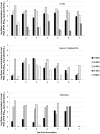Low-pathogenic avian influenza viruses in wild house mice
- PMID: 22720076
- PMCID: PMC3376105
- DOI: 10.1371/journal.pone.0039206
Low-pathogenic avian influenza viruses in wild house mice
Abstract
Background: Avian influenza viruses are known to productively infect a number of mammal species, several of which are commonly found on or near poultry and gamebird farms. While control of rodent species is often used to limit avian influenza virus transmission within and among outbreak sites, few studies have investigated the potential role of these species in outbreak dynamics.
Methodology/principal findings: We trapped and sampled synanthropic mammals on a gamebird farm in Idaho, USA that had recently experienced a low pathogenic avian influenza outbreak. Six of six house mice (Mus musculus) caught on the outbreak farm were presumptively positive for antibodies to type A influenza. Consequently, we experimentally infected groups of naïve wild-caught house mice with five different low pathogenic avian influenza viruses that included three viruses derived from wild birds and two viruses derived from chickens. Virus replication was efficient in house mice inoculated with viruses derived from wild birds and more moderate for chicken-derived viruses. Mean titers (EID(50) equivalents/mL) across all lung samples from seven days of sampling (three mice/day) ranged from 10(3.89) (H3N6) to 10(5.06) (H4N6) for the wild bird viruses and 10(2.08) (H6N2) to 10(2.85) (H4N8) for the chicken-derived viruses. Interestingly, multiple regression models indicated differential replication between sexes, with significantly (p<0.05) higher concentrations of avian influenza RNA found in females compared with males.
Conclusions/significance: Avian influenza viruses replicated efficiently in wild-caught house mice without adaptation, indicating mice may be a risk pathway for movement of avian influenza viruses on poultry and gamebird farms. Differential virus replication between males and females warrants further investigation to determine the generality of this result in avian influenza disease dynamics.
Conflict of interest statement
Figures


References
Publication types
MeSH terms
LinkOut - more resources
Full Text Sources
Medical

